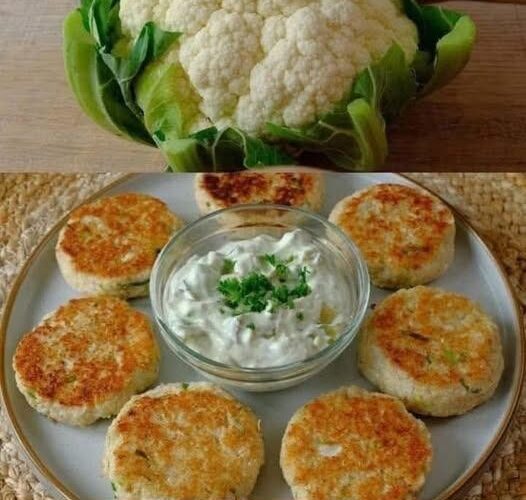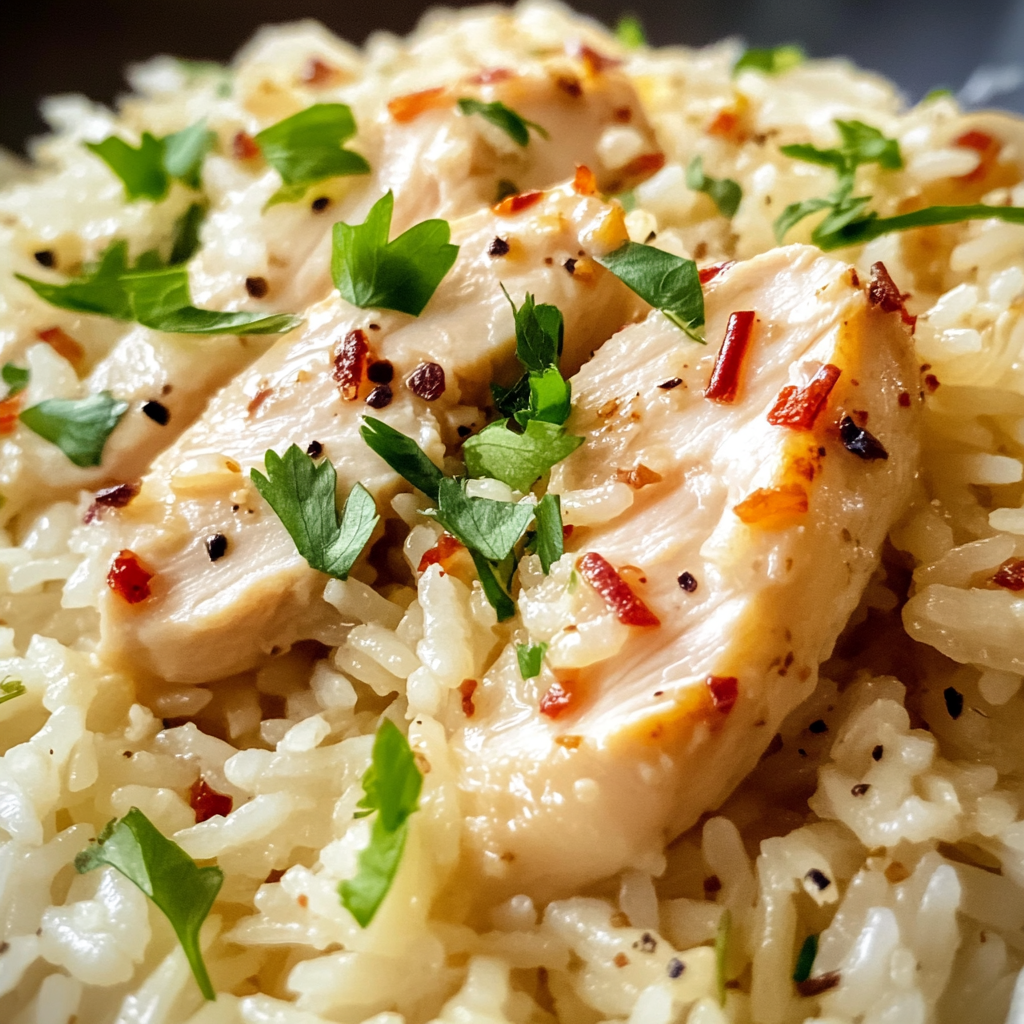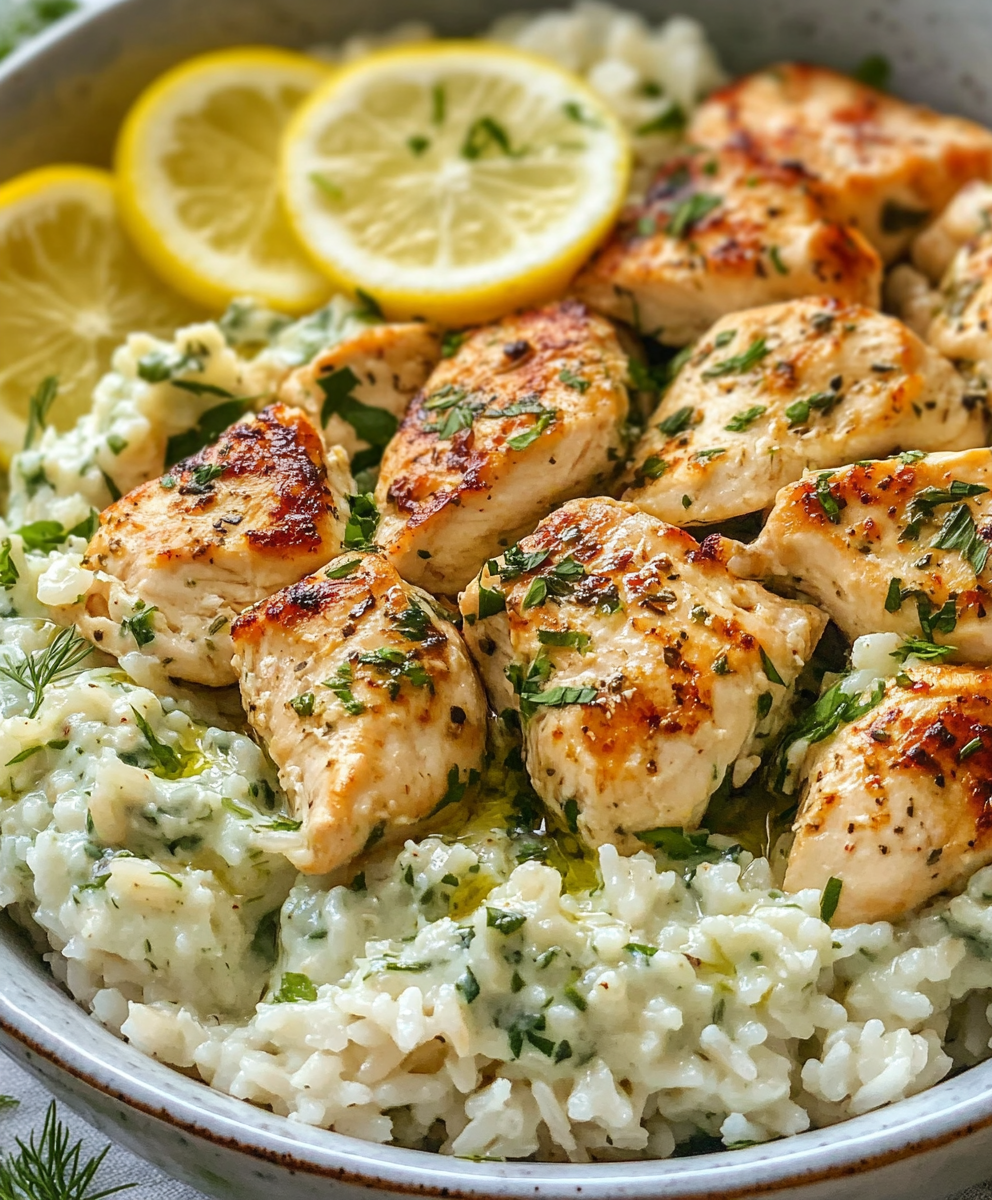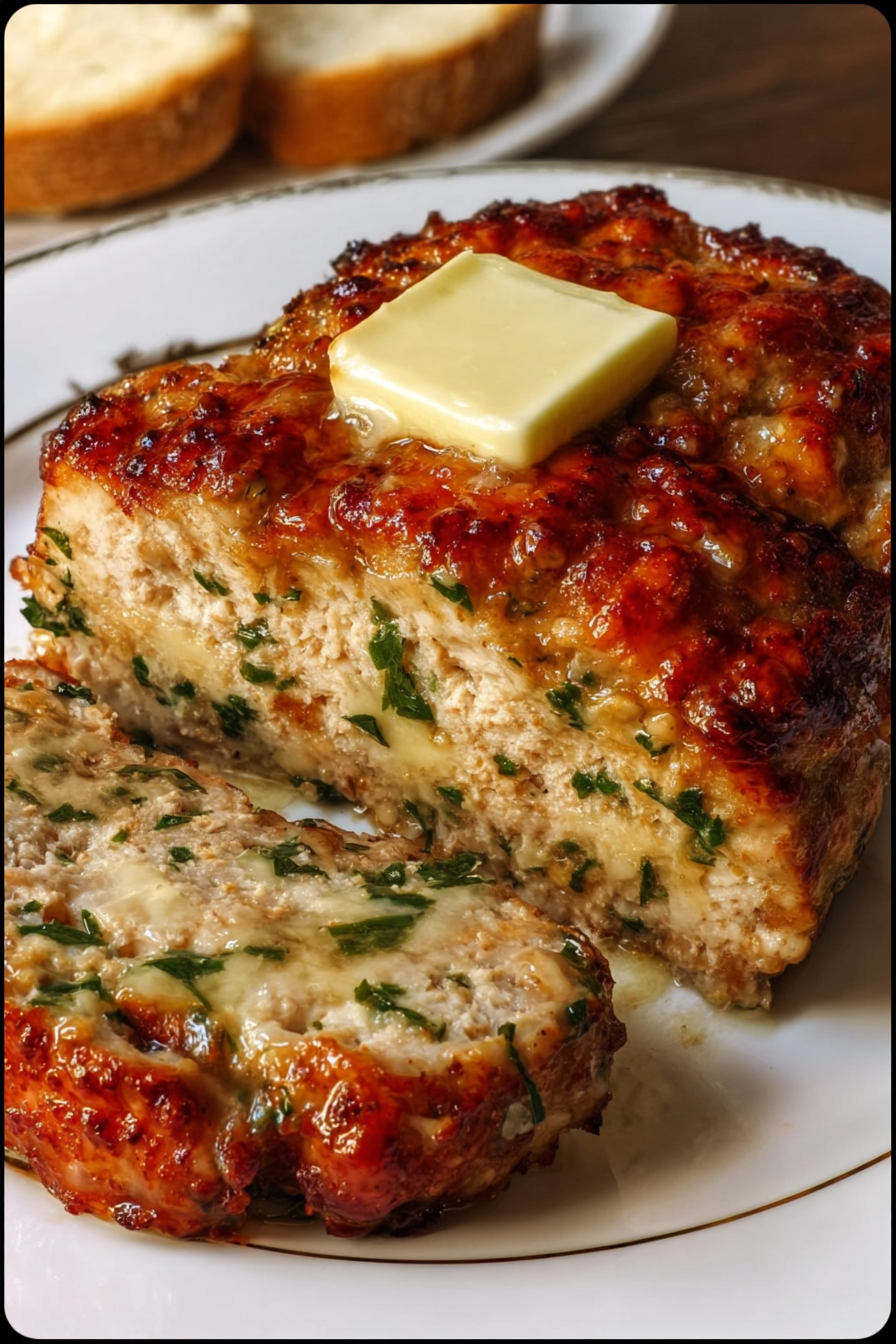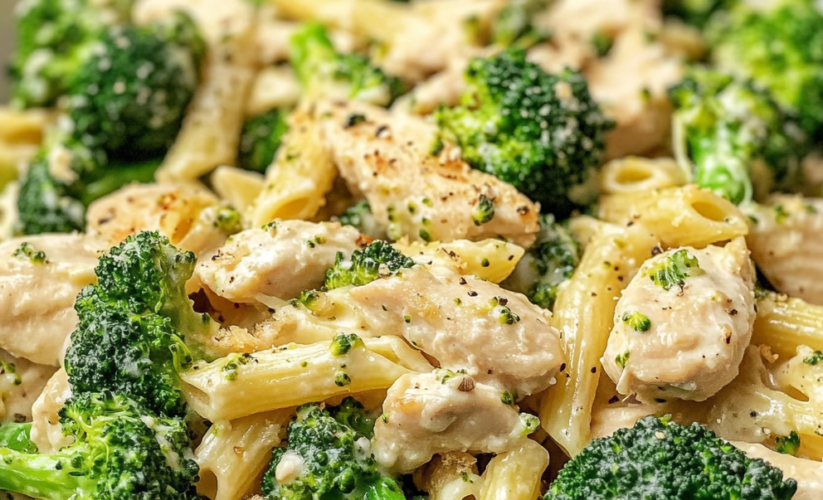
Creamy Garlic Chicken and Broccoli Pasta
This is the pasta that solves the eternal weeknight dilemma—how to get a home-cooked meal on the table that tastes like you spent hours in the kitchen when you really spent 30 minutes. Tender chicken and perfectly crisp-tender broccoli swim in a garlic-infused cream sauce that clings to every ridge of pasta, creating the kind of dinner that has everyone asking for seconds while you casually mention it’s just something you “threw together.”
Ingredients
For the Pasta and Vegetables:
- 1 pound penne or rigatoni pasta
- 4 cups broccoli florets (about 1 large head)
- 2 tablespoons olive oil
- Salt for pasta water
For the Chicken:
- 1½ pounds boneless, skinless chicken breasts
- 2 teaspoons Italian seasoning
- 1 teaspoon garlic powder
- 1 teaspoon salt
- ½ teaspoon black pepper
- ½ teaspoon paprika
- 3 tablespoons olive oil
For the Creamy Garlic Sauce:
- 4 tablespoons butter
- 8 cloves garlic, minced
- 3 tablespoons all-purpose flour
- 2 cups chicken broth
- 1½ cups heavy cream
- 1 cup freshly grated Parmesan cheese
- ½ teaspoon red pepper flakes (optional)
- ½ teaspoon dried oregano
- ¼ teaspoon nutmeg
- Salt and pepper to taste
- 2 tablespoons fresh lemon juice
For Garnish:
- Fresh parsley, chopped
- Extra Parmesan cheese
- Lemon wedges
- Cracked black pepper
Instructions
- Prep Your Mise en Place: Before starting, mince garlic, cut broccoli into uniform bite-sized florets, and cube chicken into 1-inch pieces. Having everything ready prevents overcooking while scrambling for ingredients.
- Start the Pasta Water: Bring large pot of water to boil with 2 tablespoons salt. The salty water seasons pasta from within and will be used for the broccoli too—efficient one-pot technique.
- Season the Chicken: Pat chicken pieces dry with paper towels. In a bowl, toss with Italian seasoning, garlic powder, salt, pepper, and paprika until evenly coated. The dry surface ensures better browning.
- Sear the Chicken: Heat olive oil in large, deep skillet over medium-high heat. Add chicken in single layer—don’t overcrowd. Sear 3-4 minutes without moving, then flip and cook another 3-4 minutes until golden. Remove to plate.
- Cook Pasta and Broccoli: Add pasta to boiling water, cook according to package directions minus 2 minutes. In the last 3 minutes of cooking, add broccoli florets directly to pasta pot. This perfectly times both components.
- Start the Sauce: In same skillet (don’t clean—those brown bits are flavor gold), melt butter over medium heat. Add minced garlic and red pepper flakes, sauté 30 seconds until fragrant but not brown.
- Make the Roux: Sprinkle flour over garlic-butter mixture, whisk constantly for 1 minute. This cooks out raw flour taste and creates thickening base for your sauce.
- Build the Cream Sauce: Slowly pour in chicken broth while whisking to prevent lumps. Bring to simmer, then add heavy cream, oregano, and nutmeg. Simmer gently 3-4 minutes until slightly thickened.
- Finish the Sauce: Remove from heat, add Parmesan cheese in handfuls, stirring until melted. Add lemon juice, then taste and adjust seasoning. The sauce should coat the back of a spoon.
- Combine Everything: Drain pasta and broccoli, reserving 1 cup pasta water. Add pasta, broccoli, and chicken to sauce. Toss everything together, adding pasta water as needed to reach desired consistency.
- Serve Immediately: Transfer to serving bowls, garnish with parsley, extra Parmesan, and fresh cracked pepper. Serve with lemon wedges for brightness.
Recipe Notes
- Prep Time: 15 minutes
- Cook Time: 20 minutes
- Total Time: 35 minutes
- Servings: 6
- Calories: 580 per serving
The Art of Weeknight Pasta Perfection
This recipe succeeds through strategic multitasking and understanding how flavors build. While seemingly simple, each step contributes to the final symphony of flavors. The key lies in overlapping tasks—while pasta cooks, sauce develops; while chicken rests, vegetables cook. This orchestration transforms 35 minutes into a meal that tastes like it simmered for hours.
The genius of cooking broccoli with the pasta eliminates extra pots and perfectly times the vegetable’s doneness. Those last 3 minutes in boiling water create crisp-tender florets that won’t turn mushy in the cream sauce. Plus, the starchy pasta water that clings to both pasta and broccoli helps the sauce adhere better.
Using the same skillet for chicken then sauce isn’t just about fewer dishes—it’s about flavor development. Those caramelized bits (fond) from searing chicken dissolve into the sauce, adding depth that clean-pan cooking can’t achieve. This professional technique costs nothing but pays huge flavor dividends.
Chicken: The Protein Perfection
The decision to cube before cooking rather than cooking whole breasts serves multiple purposes. Smaller pieces cook faster and more evenly, crucial for weeknight efficiency. The increased surface area means more seasoning coverage and more of those delicious caramelized edges that make each bite interesting.
That two-stage cooking—searing then finishing in sauce—prevents the dreaded rubber chicken syndrome. The high-heat sear develops flavor and color, while the gentle simmer in sauce completes cooking without toughening. Removing chicken during sauce-making prevents overcooking while building fond.
The seasoning blend does double duty: the Italian seasoning, garlic powder, and paprika create a flavor base that complements the creamy sauce while the salt helps the chicken brown better through improved protein structure. Paprika adds color that makes the dish visually appealing—we eat with our eyes first.
Mastering Cream Sauce Without Fear
Cream sauces intimidate many home cooks, but understanding the process eliminates anxiety. The butter-flour roux serves as both thickener and insurance policy against breaking. That one minute of cooking isn’t arbitrary—it eliminates raw flour taste while developing nutty notes that enhance the final sauce.
The gradual addition of liquids prevents lumps through temperature control. Adding cold broth to hot roux would shock the proteins and create clumps. The whisking motion ensures even distribution while the gradual heating allows starch granules to swell evenly, creating silky smoothness.
Heavy cream versus half-and-half isn’t about calories—it’s about stability. Heavy cream’s higher fat content prevents curdling when heated and creates luxurious mouthfeel. The sauce will be thinner with half-and-half and more prone to breaking. Sometimes richness serves a purpose beyond indulgence.

The Garlic Game
Eight cloves seems excessive until you understand garlic’s behavior in cream sauce. The dairy mellows garlic’s sharpness while the gentle cooking develops sweetness. This quantity provides backdrop flavor without overwhelming—the garlic should enhance, not dominate.
Mincing matters more than you’d think. Finely minced garlic distributes evenly and cooks uniformly. Large chunks can burn outside while staying raw inside, creating bitter notes. A microplane works beautifully here, creating paste that melts into the sauce.
That 30-second sauté window is critical. Undercooked garlic tastes harsh; overcooked turns bitter. Watch for the moment it becomes fragrant and immediately proceed with flour. The residual heat continues cooking while the flour provides protection from burning.
Pasta Selection and Cooking
Penne and rigatoni aren’t random suggestions—their ridges and tubes capture cream sauce beautifully. Long pasta like spaghetti would work but provides less sauce-holding surface area. The short shapes also match the chicken and broccoli size for balanced forkfuls.
That “minus 2 minutes” cooking instruction ensures pasta finishes cooking in the sauce, absorbing flavors while releasing starch that helps bind everything. Fully cooked pasta can’t absorb sauce and often becomes mushy when tossed with hot liquid.
Proper salting—2 tablespoons for 4-6 quarts water—seems excessive but is crucial. Pasta absorbs minimal salt, but what it does absorb seasons from within. Under-salted pasta water produces bland pasta that no amount of salty sauce can fix. Think sea water, not soup.
The Supporting Cast
Each supporting ingredient plays a specific role. Red pepper flakes provide gentle heat that cuts through richness. Oregano adds herbal notes that brighten heavy cream. That pinch of nutmeg—classic in cream sauces—adds warmth without identifiable nutmeg flavor, just mysterious depth.
Fresh lemon juice added at the end serves multiple purposes: brightening flavors dulled by cream, adding acidity that balances richness, and preventing the sauce from feeling heavy. Add off heat to preserve bright flavor and prevent curdling.
Pasta water is liquid gold—the starch content helps bind sauce to pasta while the salted water adds seasoning. Always reserve more than needed. You can’t go back for more once drained, and this starchy water fixes many sauce consistency issues.
Timing and Temperature Control
Success hinges on understanding heat management. High heat for searing chicken develops flavor. Medium heat for sauce prevents scorching while allowing proper thickening. Off heat for adding cheese prevents breaking and graininess. Each temperature serves a specific purpose.
The resting time while making sauce allows chicken juices to redistribute, ensuring moist meat. This built-in rest period exemplifies the recipe’s efficient design—necessary techniques overlap rather than extending cooking time.
Serving immediately isn’t just about hot food—cream sauces continue thickening as they cool. What looks perfect in the pan becomes gluey on the plate if held too long. Having everything ready—bowls warmed, garnishes prepped—ensures optimal consistency.
Customization Options
Vegetable Variations: Asparagus, snap peas, or spinach substitute beautifully. Adjust cooking times—asparagus needs 2 minutes, spinach just wilts in hot pasta. Mushrooms sautéed with garlic add earthiness.
Protein Swaps: Shrimp cooks even faster—add during last 3 minutes of sauce simmering. Italian sausage (removed from casings) creates heartier version. For vegetarian, try chickpeas or white beans.
Lighter Version: Replace half the cream with evaporated milk, use light butter, reduce cheese slightly. Still creamy but less caloric. Greek yogurt stirred in off heat adds tanginess and protein.
Gluten-Free: Substitute pasta with gluten-free version (cook separately as timing differs). Use cornstarch slurry instead of flour roux—whisk 2 tablespoons cornstarch with cold broth before adding.
Flavor Boosters: Sun-dried tomatoes add sweetness and chew. Capers bring brininess. Fresh basil stirred in at end provides aromatic finish. Truffle oil drizzle creates restaurant-worthy presentation.
Troubleshooting Common Issues
“Sauce is too thin”: Simmer longer to reduce or add pasta water’s starch. Toss more vigorously—the motion helps starch bind sauce. More cheese also thickens while adding flavor.
“Sauce broke/looks curdled”: Temperature too high or cheese added on heat. Remove from heat, whisk in splash of cream to re-emulsify. Prevent by maintaining gentle heat and adding cheese off heat.
“Bland flavor”: Under-seasoned at multiple points. Taste and adjust after each addition. Needs more salt, lemon juice, or garlic. Freshly cracked black pepper at serving makes huge difference.
“Broccoli overcooked”: Added too early to pasta water. Three minutes maximum for crisp-tender. If overcooked, add fresh broccoli sautéed separately next time for textural contrast.
“Chicken dry”: Overcooked during searing or sauce simmering. Reduce initial cooking time—chicken continues cooking in sauce. Dark meat (thighs) forgives overcooking better than breasts.
Make-Ahead Strategies
While best served fresh, components can be prepped. Season chicken and refrigerate up to 24 hours—longer marination deepens flavor. Cut broccoli and store in water. Grate cheese and measure spices.
For meal prep, slightly undercook everything. Store sauce separately from pasta and vegetables. Reheat gently with splash of cream or broth to revive sauce. Add fresh lemon juice and herbs after reheating to brighten flavors.
Leftovers transform beautifully. Thin with broth for soup. Bake with extra cheese for pasta bake. Stuff into omelet for decadent brunch. The flavors often improve overnight as they meld.
Serving Suggestions
Present family-style in large bowl for casual dinners—the communal serving encourages seconds. For date night, plate individually with protein arranged on top, extra Parmesan, and herb garnish for restaurant presentation.
Garlic bread seems redundant but soaks up extra sauce beautifully. Simple green salad with lemon vinaigrette cuts through richness. Crisp white wine like Pinot Grigio or Sauvignon Blanc complements without competing.
This pasta works as main course or scaled-down side dish. Half portions alongside grilled steak or roasted salmon create impressive dinner party spread. The creamy sauce bridges various proteins beautifully.
Final Thoughts
This Creamy Garlic Chicken and Broccoli Pasta embodies everything great about home cooking—it’s faster than takeout, more satisfying than frozen dinners, and infinitely customizable to your family’s preferences. It proves that weeknight cooking doesn’t mean sacrificing flavor or technique. Master this recipe and you’ll have a reliable dinner solution that never gets old thanks to endless variation possibilities. The combination of tender chicken, perfect vegetables, and that silky garlic cream sauce creates comfort food at its finest—sophisticated enough for company yet simple enough for Tuesday night.
